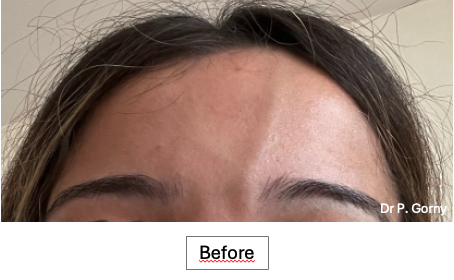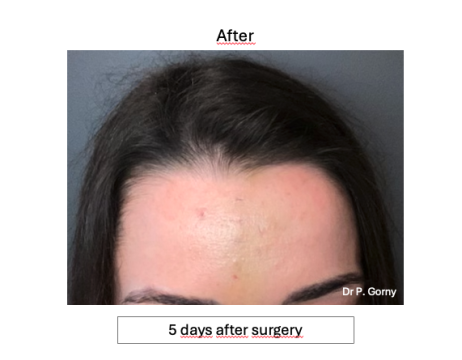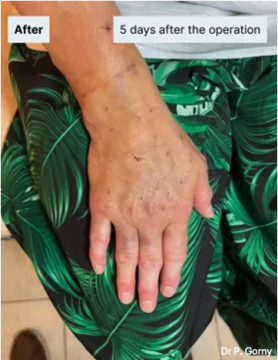4Bulging veins on the face, hands, breasts and décolleté
The veins in question here are superficial subcutaneous veins (located beneath the skin), not varicose, but prominent and highly visible, as they are significantly disproportionate to others that are not. This is due to:
- Lean subcutaneous fatty tissue.
- Vascular walls that have lost their tone.
- A reduction in elastic and collagen fibers in the skin leading to loosening.
- The appearance of a bluish color that accentuates them further.
- Localized venous trauma.
- Genetic predisposition may also contribute to their appearance.
Some facial veins, especially in the temples, forehead, or periorbital area, which usually only dilate during exertion, may remain dilated at rest over time, becoming a permanent aesthetic concern.
Injecting a sclerosing agent is sometimes proposed to treat these imperfections, but it is a lengthy, multi-step process that can be dangerous when used on facial veins (a formal contra-indication). In addition, the erasure of veins via this technique is rarely complete. Laser treatment is also sometimes suggested but can be disappointing as it is also often partial, and there is a risk of burns due to the larger diameter of the swollen veins necessitating more thermal energy delivery than in the case of spider veins (also referred to as thread veins or venous flares). The subcutaneous filling effect of hyaluronic acid treats surface irregularities but not the underlying issue, with its effect often being temporary (up to 6 months at most) and not entirely satisfying either.
For these swollen veins, the most effective and quickest treatment is the removal of the unsightly segment via phlebectomy. This technique involves making one or multiple, quickly invisible, millimeter incisions using a specific tiny hook to grasp and extract or section the offending vein subcutaneously. The procedure, usually carried out under local anesthesia or sometimes light sedation, is outpatient, and the results are almost immediate. Bruising is minimal due to applying cold pressure for 10 minutes post-operation.
It should be noted that phlebectomy on the face, hands, or décolleté requires a different approach compared to the more common phlebectomy for lower limb varicose veins, as veins in these areas are strongly embedded in subcutaneous tissues. Particularly in the hands and face, extensive knowledge of the superficial venous network anatomy is necessary to maintain proper surface drainage, as well as technical skill to avoid damaging smaller sensory nerves often close to these veins. The operator’s experience in this field is a key factor. Dr. Philippe Gorny has been a pioneer in this aesthetic venous surgery for over 25 years, creating dedicated surgical instruments for the procedure.
Click photo to enlarge
These veins should be distinguished from varicose veins in the lower limbs, which are twisted and dilated, located beneath the skin, and for which various effective surgical solutions exist (see the section varicose veins on our website by clicking on institut-veines.com)
They should also not be confused with superficial colored micro-veins that can form red, blue, or purple spots on the skin, known as telangiectasias (or spider veins), whether on the lower limbs, cheeks, nose (commonly referred to as rosacea), or cheeks (erythrosis). Various energy-based treatments (laser, electrocoagulation, intense pulsed light) are available to address these purely cutaneous aesthetic disorders, as well as sclerosant injections away from the face.



























